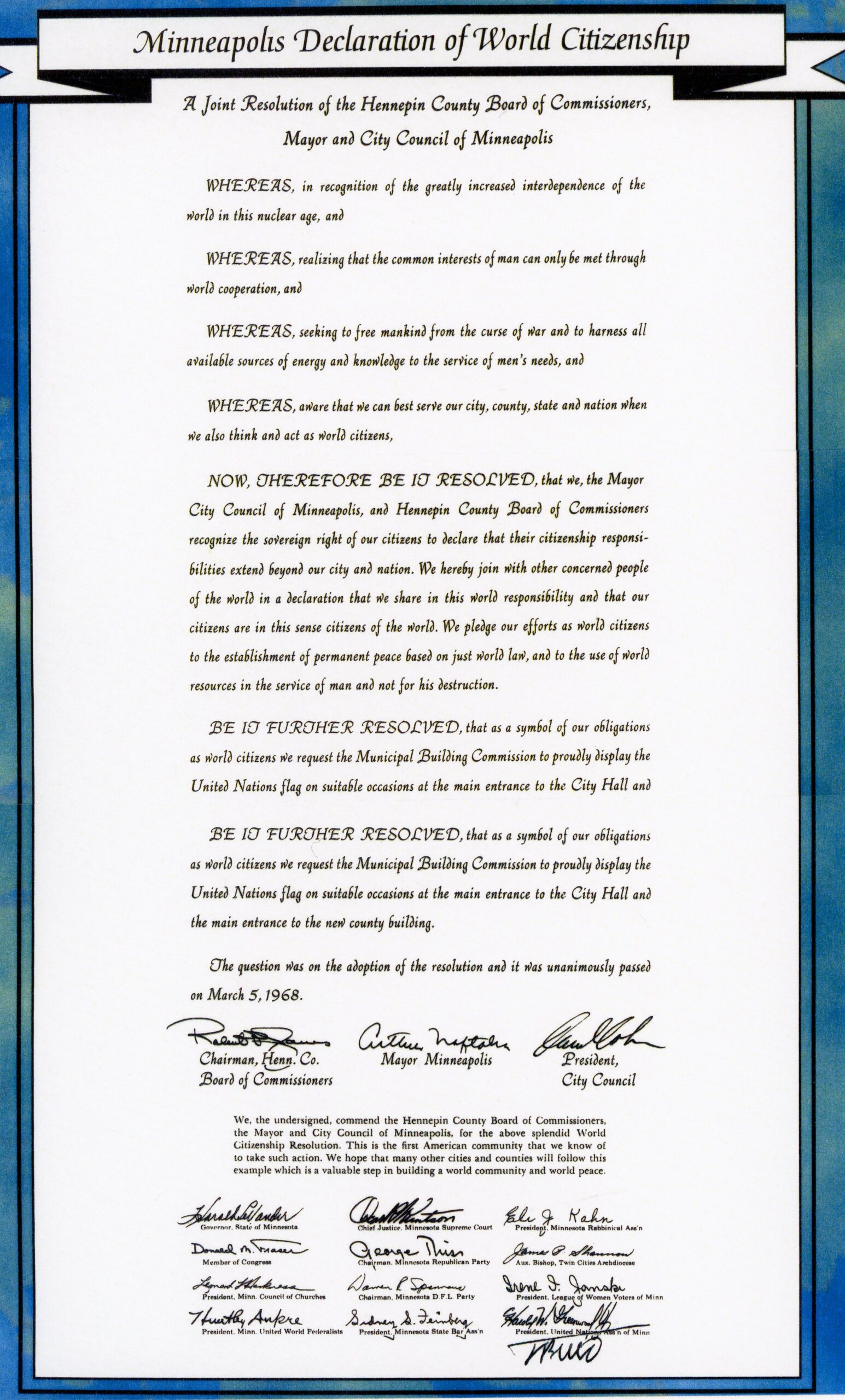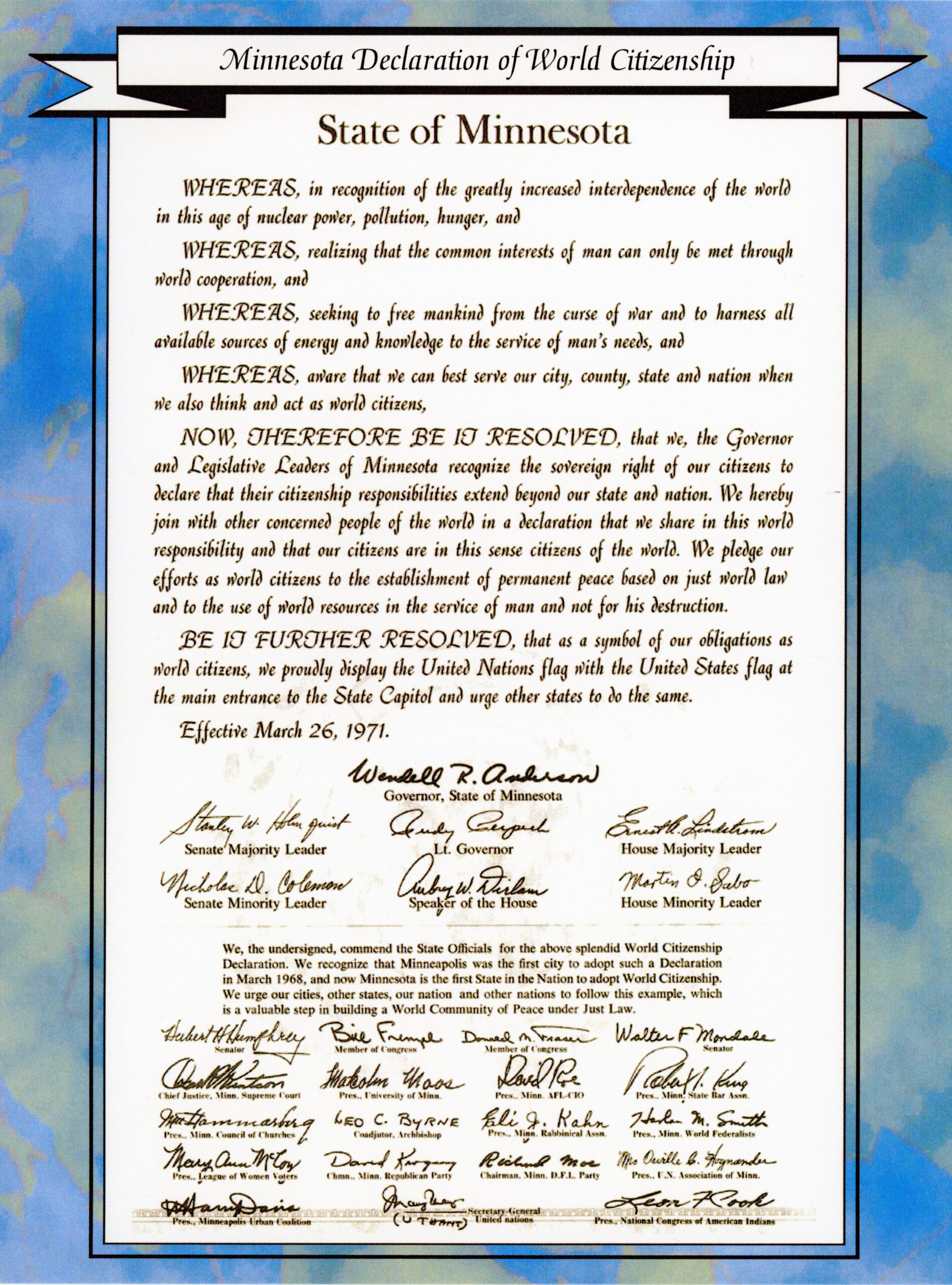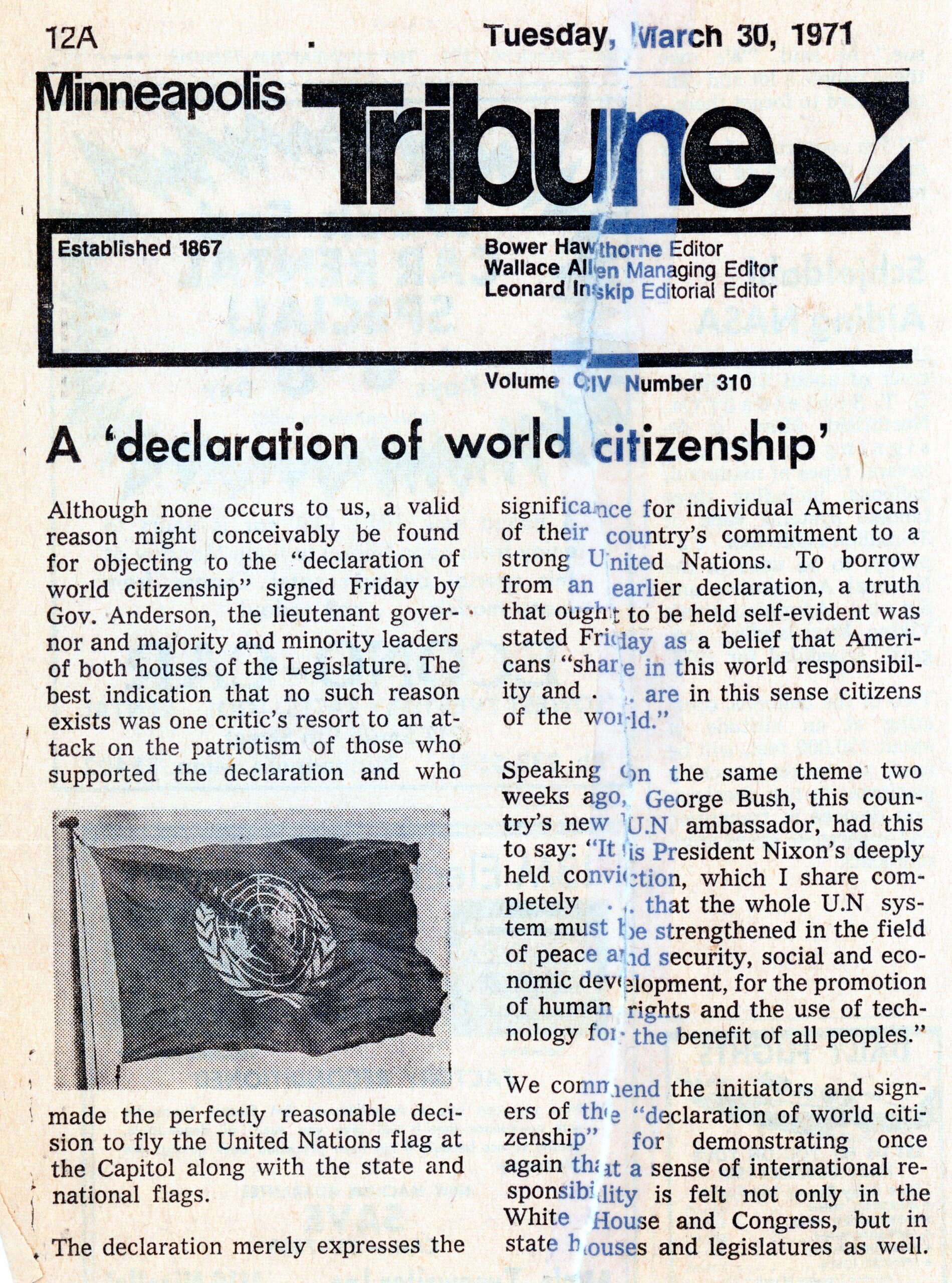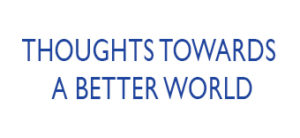NOTE: This post originated in November, 2007, titled LYNN ELLING: A MILLION COPIES MADE: Visioning a New Declaration of World Citizenship, by Dick Bernard. Originally published Nov. 5, 2007 at Minnesota Alliance of Peacemakers, of which Dick Bernard was then President, slightly revised February 3, 2011, and December 3, 2012, and has been updated by addition several times, most recently Nov. 22, 2020. Mr. Elling died in Minneapolis MN, February 14, 2016.
*
I don’t know why Ed McCurdy chose the line “a million copies made” for his circa 1950 peace anthem, “Last Night I Had The Strangest Dream”.
Nor do I know why John Denver especially liked that song (a 1971 rendition performed by him on the U.S. Capitol steps is still available on YouTube.)
All I know is that I heard Lynn Elling lead us in singing that song back in the spring of 2007; and that the lyric “A million copies made” has stuck with me.
Who is this Lynn Elling?
And what does he have to do with peace and justice?
Plenty.
As a young LST (Landing Ship Tank #172) officer in WWII, Lynn Elling saw the horrors of War closeup in the South Pacific, at places like Tarawa. The history of LST 172 is here: Lynn Elling LST 172001,
Later he was recalled to service, and served in the Korean conflict, also on an LST.

Lynn Elling on USS LST 172 in the Pacific, 1944
Born in 1921 and a life long Minnesotan, after WWII Elling entered the insurance and financial planning business with Lincoln Life, becoming very successful in the profession. But early in his post-war career, he was discouraged and almost quit. Selling is very hard work. At a critical point in his early professional life, 1947, a workshop leader, Maxwell Maltz (Psycho Cybernetics) unlocked the door to Lynn’s future success. Maltz taught that if one could visualize a goal in technicolor, 3-dimension and stereophonic sound, the goal could be achieved. Elling listened, and followed Maltz’s advice, and it worked.
But Elling never forgot what he’d seen and experienced on that LST in the south Pacific in WWII.
Assorted experiences after WWII, including the service in the Korean conflict and visiting Hiroshima in 1954 and again in 1963, and opportunities to meet with and get to know people like Thor Heyerdahl (Kon Tiki), Norman Cousins, and many others, led to Lynn’s life long passion to build a culture of Peace and World Citizenship. Through leaders like MN Gov. Wendell R. Anderson, and mentors like Minneapolis business executive Stanley Platt, his wife Martha Platt, former Minnesota Governor Elmer L. Andersen and others, Elling was encouraged in his efforts.
His enduring monument is World Citizen, Inc.. World Citizen is a long-time member of Minnesota Alliance of Peacemakers (MAP).
In the Fall of 1967, Stanley Platt and Lynn worked with then-Minneapolis Mayor Arthur Naftalin on a Declaration of World Citizenship, patterned on a then rapidly expanding program called “Mundialization” of cities particularly in Japan, France and Canada. Mayor Naftalin took the lead on the initiative, and on March 5, 1968, Minneapolis City Council and Hennepin County Board of Commissioners approved the resolution and the Declaration was signed by numerous parties. Here is a photo of a copy of the 1968 Declaration:

This was the first such declaration by a United States City. Signers of the Declaration and twenty-eight mayors from area communities attended the public declaration on Law Day, May 1, 1968.
Signers of the Declaration were: Chair, Henn. Co Board of Commissioners Robert Janes; Mayor of Minneapolis Arthur Naftalin; President Minneapolis City Council Daniel Cohen; Gov. Harold Levander; Oscar Knutson, Chief Justice Minnesota Supreme Court; Eli Kahn, President Minnesota Rabbinical Association; Congressman Don Fraser; Chairs of Minnesota Republican and DFL parties, George Thiss and Warren Spannaus; Aux. Bishop of Catholic Archdiocese James Shannon; Irene Janski, President of MN League of Women Voters; President MN United World Federalists, Sidney Feinberg, Minnesota State Bar Assoc; Harold Greenwood Jr, United Nations Association of Minnesota.
Former MN Governor Elmer L. Andersen spoke at the ceremony that day, very proud that the occasion marked “the first flying of the United Nations flag by Minneapolis and Hennepin County, [and] the first such declaration and UN flag flying by any major community in the United States. Thus this becomes a deeply significant occasion in our nation’s history. It represents a commitment to cooperation among nations for world peace, to belief in the common brotherhood of all men of all nations, and to aspirations for a world community of peace, freedom and justice under world law.“
In the same speech, he said “that we must look upon all the peoples of the world as one community, and we must find a way to operate under a body of world law to preserve peace.” (quotes from pages 151-52 of I Trust to be Believed, significant speeches by Elmer L. Andersen edited by Lori Sturdevant 2004). Text: Elmer Andersen I Trust..001

Elmer L. Andersen speech, City Hall, Minneapolis, May 1, 1968. Photo by Donna Elling

Gov. Elmer L. Andersen (center left) with Minneapolis Mayor Arthur Naftalin, May 1, 1968, Minneapolis City Hall. Photo by Donna Elling.

Lynn Elling speaks at May 1, 1968, ceremony at Minneapolis City Hall. In foreground, holding the Declaration, is Warren Spannaus, then Chair of the Minnesota DFL party, later Attorney General. Phot by Donna Elling.
Lynn’s passion for peace continued with another remarkable achievement in the spring of 1971 when 26 prominent leaders, including all notable Minnesota Republicans and Democrats, and then-UN Secretary General U Thant, signed a declaration of World Citizenship whose major proviso recognized “the sovereign right of our citizens to declare that their citizenship responsibilities extend beyond our state and nation. We hereby join with other concerned people of the world in a declaration that we share in this world responsibility and that our citizens are in this sense citizens of the world. We pledge our efforts as world citizens to the establishment of permanent peace based on just world law and to the use of world resources in the service of man and not for his destruction.”
Coming as it did during the darkest times of the Vietnam War, the 1971 bi-partisan Declaration is remarkable. Similar declarations were entered into in several other states and many communities.
See amillioncopies.info for more information about the entire declaration, which includes the signatures of all its very prominent signers.
In 1971, the Vietnam War raged on. It was difficult for most Americans to visualize an end to the deadly conflict. For those old enough to remember, the late 1960s and early 1970s was a time of deep division in this country. American youth were dying by the thousands in southeast Asia, as were millions of fellow world citizens in southeast Asian countries.

Here’s a Minneapolis Star Tribune editorial about the 1971 Minnesota Declaration:
Also accessible at the website is [the Elling led] 1972 film, “Man’s Next Giant Leap”, featuring John Denver and many then-notable Minnesota leaders, whose sole purpose was Peace Education for children and adults.
In 1972, Lynn and others founded World Citizen, Inc; in 1988, Peace Sites became integral to World Citizen. Peace Poles have been publicized by World Citizen for many years.
In 1996 Lynn Elling co-founded the Nobel Peace Prize Festival, later part of Nobel Peace Prize Forum, at Augsburg College in Minneapolis. The programs continued until 2018.
As so often happens, after a flurry of attention, the remarkable 1971 declaration literally ended up in a closet, its immense significance unnoticed by later generations.
Lynn Elling never forgot the 1971 declaration and in the spring of 2007 put it back on the table.
Today, of course, we are confronted by circumstances even more compelling and troubling than visited the U.S. and the world in 1971.
Today war is almost an abstract reality for many of us, something that seems to have no apparent negative consequences for us, mostly affecting people we’ll never see face-to-face, with fewer of ‘our own’ dying in places far away, no military draft facing young people, our war financed on a national credit card for our grandchildren to pay.
In a real sense we are playing a deadly video game. Additionally, we are beset with other potentially calamitous problems ignored at our peril. No longer can we pretend that our problems are confined to some other place far away, or even controllable by our own will. We are vulnerable in a way that we do not want to understand.
There has never been a greater need for world citizenship than there is today.
When Lynn secured his last signature on the 1971 declaration, achieving mastery in the space race was still a priority. Today, our very survival as human beings is rooted on what is happening on our own planet in all ways: human relationships, resource depletion, increasing inequities between peoples, climate change…the list goes on and on. Today’s priority must be right here on the sphere we call home – the earth. We are part of the global community; isolation and domination are no longer options.
Lynn Elling deserves immense credit and admiration for not only his accomplishment in 1971, but for reigniting the issue for today’s world.
Thanks, Lynn, for all you’ve done.
To all of you, stay tuned as we “retool and refuel” Lynn’s dream and take it, as he likes to say, “to the stratosphere”.

Lynn Elling World Service Authority Passport Photo 1975
UPDATE, May 7, 2016:
LYNN ELLING, Minneapolis MN, died February 14, 2016, a few days short of 95 years of age. You can read his obituary here. A followup feature obit was published in the Minneapolis paper on February 25, 2016, can be read here. See also Celebration May 1 2016001 of his life on May 1, 2016.
Mr. Elling was a giant for peace. My personal attempts to summarize his life can be read below. My knowledge of his work, very minimal at first, expanded with virtually every visit during the 9 years I was privileged to know him.
He was a remarkable missionary for Peace, born of his experience during and following World War II. (More here: Lynn U.S. Navy001)
On May 14, 2014, as part of an archival project focusing on Peace Elders in Minnesota, Ehtasham Anwar and Suhail Ahmed, both of Pakistan, did a 57 minute video of Mr. Elling recalling his years as a peace activist.
The unedited film can be viewed in its entiretyat AMillionCopies.info. The occasional voices in the background are Ehtasham (doing the interview) and Dick Bernard.
My comment about the interview, as it appears at the YouTube site, is: “Mr. Elling was 93 at the time of this interview in Minneapolis, MN May 14, 2014. I was privileged to be part of the interview planning and process, and from time to time I’ll interject a comment or question in this film. The interviewer is Ehtasham Anwar, then a Fulbright/Humphrey Fellow at the University of Minnesota Law School Human Rights Center. This interview was part of a project to interview ten elders in the peace movement. Mr. Elling’s was the second interview in the series, which was completed in mid-June, 2014. This video is unedited – it is essentially raw video – thus no effort has been made to correct content. I knew Mr. Elling for seven years before this interview. His memory as shared in this video was basically very sound, based on my own knowledge of his work, and past events. Any errors can be excused. He was a man who “walked the talk” for his passion of peace. He died February 14, 2016, days short of his 95th birthday. He was promoting peace until his death.”
Mr. Elling identified particularly with several organizations which still exist in the Twin Cities:
* World Federalists, now Citizens for Global Solutions MN.
* United Nations Association. It was during his time with UNA that he produced the film “Man’s Next Giant Leap” in 1972. The film, which can be viewed here, features singer John Denver and many Twin Cities civic and community leaders.
Mr. Elling served at one time as President of both of the above local organizations.
* World Citizen, was an organization he founded in 1972, and in which he was active until his death. I would say World Citizen was always the organization of which he was most proud.
* He was one of the Charter Members of Minnesota Alliance of Peacemakers, founded 1995-96.
* In 1996, Lynn co-founded the Nobel Peace Prize Festival an annual event for years, and later was merged with the Nobel Peace Prize Forum. He participated in these events until his final years.
* Mr. Elling was a Founding Member of the U.S. Peace Memorial Foundation. He was been nominated for that organizations annual Peace Prize for 2016. The application letter is here: Lynn Elling nom Apr 2016001
* annually, Mr. Elling participated in the re-dedication of Jefferson High School in Bloomington MN as a Peace Site, and indeed at other places. His passion for peace sites was avid, from the time he first learned of the concept in 1982.
* Concordia Language Villages at Bemidji, at which he dedicated as a peace site in 1996, and annually participated in a rededication of that most impressive peace site.
* As a Naval officer in WWII who saw the horrors of war, Mr. Elling would share the ideals and aspirations of the Veterans for Peace.
* perhaps more than anyone else, Mr. Elling was instrumental in the flying of the United Nations flag at what is now the Hennepin County Government Center, May 1, 1968. The flag flew there, next to the United States flag, until March 27, 2012. Here is what Lynn wrote about the history of the flag in May, 1968: May 1 1968 UN Flag Mpls001. Much more about this issue can be read here.
He is at Peace. His mission must continue.
Dick Bernard
dick.bernard@icloud.com
May 16, 2016
* * * * *
UPDATE December 11, 2013: Personal statement: Dick Bernard.
I initiated A Million Copies website in March, 2008. At the time, I had known Mr. Elling for only nine months. As time passes, he continues as a most remarkable and committed seeker of Peace in our world. For the interested reader, place the words Lynn Elling in the search box of this blog, and you will find many other posts which refer to him in one way or another. He walks the talk for Peace. I’m honored to know him. Here is a recent summary of his experience/work for peace over the last 80 years: Lynn Elling Timeline 1943-2013. The most recent post which relates specifically to Mr. Elling is about the U.S. Declaration of World Citizenship signed by President Lyndon Johnson in 1965. You can read it here.
UPDATE June 20, 2012: Lynn’s spouse of 68 years, Donna Elling, passed away June 1, 2012. Here is a blog post about Donna and Lynn and their family, first posted on the day of her Memorial Service June 13, 2012.
UPDATE January 4, 2013: During the fall and early winter of 2012, I found more information particularly about the Minneapolis/Hennepin County Declaration of World Citizenship March 5, 1968. That information has been added to this post, including some photos of the May 1, 1968, dedication ceremony taken by Donna Elling.
I met Lynn Elling in June, 2007. In November of that year I wrote the below commentary for Minnesota Alliance of Peacemakers (original here), and in March, 2008, I rolled out the Million Copies website tribute to Lynn Elling and Professor Joe Schwartzberg, which remains essentially identical to when it was first published.
Both Mr. Elling and Dr. Schwartzberg remain with us, and both remain very, very active in their respective passions.
This seems to be a good time to update the original commentary about Lynn. (Changes to original text are minimal. The photographs are new additions.)
March 1-3, 2012 inaugurates the new Augsburg Nobel Peace Prize Forum, incorporating the long existing Nobel Peace Prize Festival, also at Augsburg, in which Lynn had a major co-founding role, and through the years has been a remaining powerful and crucial presence as both worker and fund-raiser for this major event.
Lynn and his spouse, Donna, still live in south Minneapolis. They celebrated 68 years of marriage last fall. Below are photos taken September 22, 2011, at their home; and in February, 1972.
(click on all photos to enlarge them)

Lynn and Donna Elling September 22, 2011

Lynn and Donna Elling World Service Authority Passport photo February 7, 1972
Lynn remains very active in working for an enduring peace, particularly with children’s programs such as Peace Sites, also here, and listing here: World Citiz Peace Sites001. And Peace Education.
Donna and Lynn, congratulations and best wishes to you both.
UPDATE April 17, 2013: Here is an abbreviated timeline of Lynn Elling’s efforts for World Peace: Lynn Elling Timeline001 It is much abbreviated.
*

Memorial Day 2013, Lynn Elling with family at their Lake Cabin, celebrate Donna’s life and inter her ashes at the base of a favored tree.


































